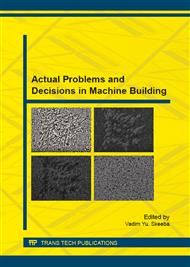[1]
V.M. Segal, V.I. Reznikov, V.I. Kopy'lov, D.A. Pavlik and V.F. Maly'shev, A plastic formation of metals, Navuka i te`hnika «Publ. », Minsk, (1994).
Google Scholar
[2]
R.Z. Valiev, I.V. Aleksandrov, Bulk nanostructured metallic materials: synthesis, structure and properties, Akademkniga «Publ. », Moscow, (2007).
Google Scholar
[3]
A.M. Ivanov, The effectiveness of combining thermoplastic processing methods of steels, Fundamental'ny'e i prikladny'e problemy' tehniki i tehnologii «Publ. ». 2-4 (2012) 25-33.
Google Scholar
[4]
V.S. Zolotorevskiy, Mechanical properties of metals, Metallurgiya «Publ. », Moscow, (1983).
Google Scholar
[5]
L.R. Botvina, Destruction: kinetics, mechanisms, general laws, Nauka «Publ. », Moscow, (2008).
Google Scholar
[6]
S.V. Dobatkin, P.D. Odesskiy, O.I. Slepcov, G.I. Raab, S.P. Yakovleva and S.V. Shagalina, The mechanical properties of submicrocrystalline steel 09G2S after ECA-pressing, Moskovskiy institute stali I splavov «Publ. ». (2004) 143.
Google Scholar
[7]
G.I. Raab, A.M. Ivanov, D.V. Gunderov, P.P. Petrov, E.S. Lukin, N.D. Petrova, A.A. Platonov and R.Z. Valiev, The increase in strength and cold resistance of structural steels intensive plastic deformation and heat treatment, Institut himii tverdogo tela I mehanohimii «Publ. ». (2007).
Google Scholar
[8]
G.V. Klevcov, R.Z. Valiev, G.I. Raab, N.A. Klevcova, M.V. Fesenyuk and M.R. Kashapov, The impact fracture mechanism 10 steel with submicrocrystalline structure in the range of ductile-brittle transition, Deformaciya i razrushenie materialov «Publ. ». 8 (2011).
Google Scholar
[9]
A.M. Ivanov, A.S. Sy'romyatnikova and N.D. Petrova, Hardening of intensive plastic deformation and fracture of constructional steel, Uprochnyayusch'ie tehnologii i pokry'tiya «Publ. ». 3 (2012) 39-42.
Google Scholar
[10]
V.E. Panin, L.S. Derevyagina, N.M. Lemeshev, A.V. Korznikov, A.V. Panin, M.S. Kazachenok, About nature of low-temperature steels embrittlement with BCC-structure, Fizicheskaya mezomehanika «Publ. ». 6 (2013) 5-12.
DOI: 10.1134/s1029959914020015
Google Scholar


